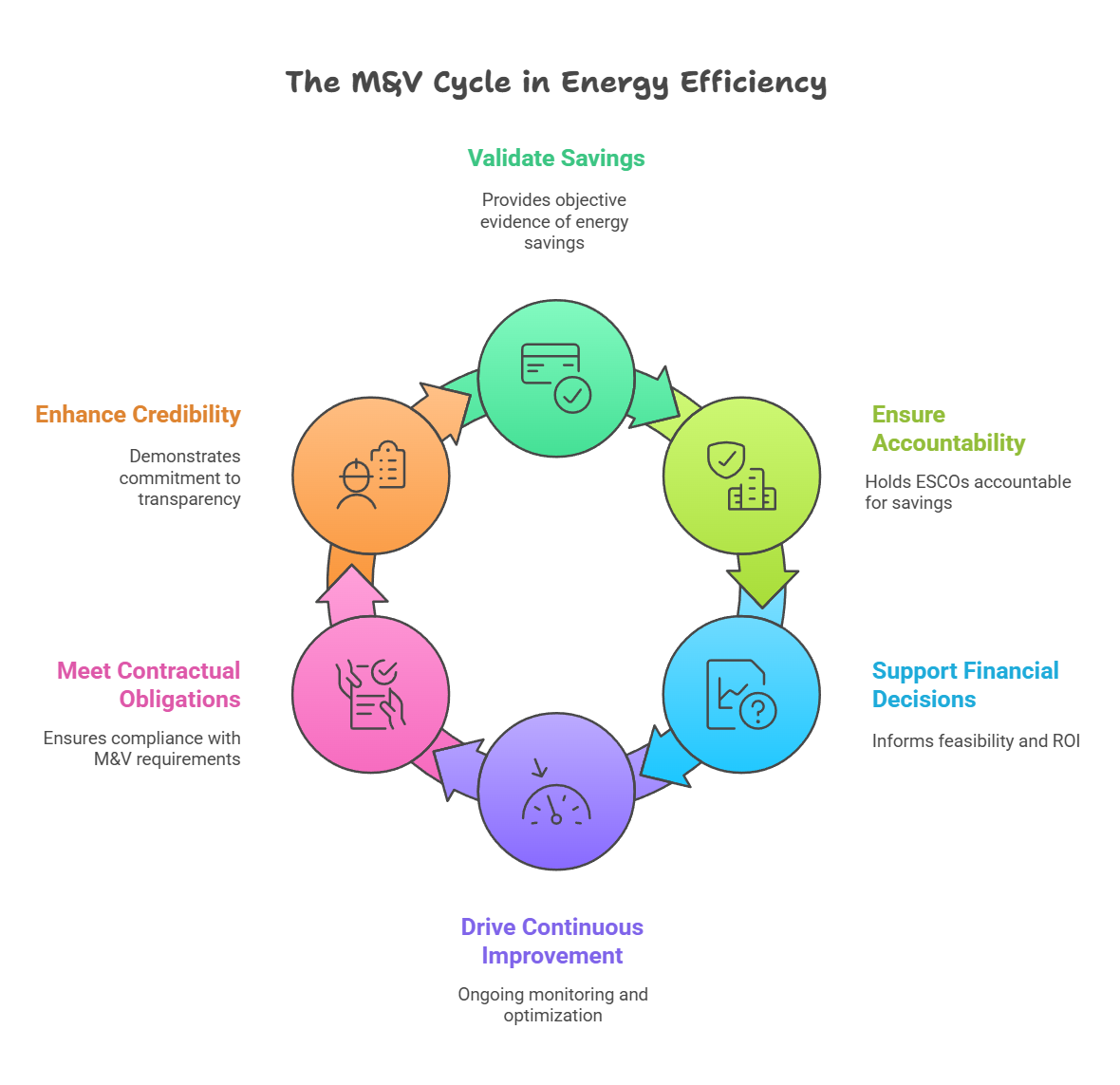Accurate Measurement & Verification (M&V) is crucial for ensuring that energy efficiency projects deliver the promised results. Learn about best practices for M&V.
As directors, managers, and executives in Energy Services Companies (ESCOs), you understand the importance of delivering successful energy efficiency projects. A key factor in achieving this success is accurate Measurement & Verification (M&V). M&V is a systematic process used to quantify the actual energy savings achieved in energy efficiency projects. It provides credible evidence that the implemented measures are performing as expected and delivering the promised financial and environmental benefits. This article will explore the critical role of M&V in energy efficiency projects, discuss different M&V methods, and highlight best practices for ensuring accurate and reliable results.
Why is M&V Important?
M&V plays a vital role in energy efficiency projects for several reasons:
- Validate Savings: M&V provides objective evidence of the energy savings achieved, validating the effectiveness of the implemented measures. This validation is crucial for building trust with clients and demonstrating the value of your services.
- Ensure Accountability: M&V holds ESCOs accountable for delivering the promised energy savings. This accountability fosters transparency and encourages continuous improvement in project implementation and performance.
- Support Financial Decisions: Accurate M&V data supports informed financial decisions for both ESCOs and clients. It helps determine project feasibility, secure financing, and track return on investment (ROI).
- Drive Continuous Improvement: M&V is not a one-time activity but an ongoing process that allows for continuous monitoring and improvement of energy efficiency projects. By tracking performance over time, you can identify areas for optimization and ensure long-term savings persistence.
- Meet Contractual Obligations: Many energy performance contracts include specific M&V requirements. Accurate M&V ensures compliance with these contractual obligations and avoids potential disputes.
- Enhance Credibility: Implementing a robust M&V plan enhances the credibility of your energy efficiency projects. It demonstrates your commitment to transparency and provides reliable data to support your claims.
M&V Methods
The International Performance Measurement and Verification Protocol (IPMVP) is a widely recognized standard for M&V in energy efficiency projects. IPMVP defines four options for M&V, each with varying levels of complexity and data requirements:
- Option A: Retrofit Isolation: Partial Measurement: This option focuses on isolating the energy efficiency measure and measuring its performance parameters. It involves partial measurement, with some parameters estimated based on engineering calculations or operational data. This option is suitable for projects with relatively simple measures and limited interactions with other building systems.
- Option B: Retrofit Isolation: All Inputs Measured: Similar to Option A, this option isolates the energy efficiency measure but requires measurement of all relevant parameters. It provides greater accuracy in savings calculations and is suitable for projects with more complex measures or where higher accuracy is required.
- Option C: Whole Building: This option measures energy savings at the whole building level, typically using utility meter data. It accounts for interactions between different energy efficiency measures and is suitable for projects with multiple measures or where isolating individual measures is challenging.
- Option D: Calibrated Simulation: This option uses calibrated simulation models to estimate energy savings. It involves creating a detailed model of the building and its energy systems and using this model to predict energy consumption with and without the implemented measures. This option is suitable for complex projects or those involving significant building modifications.
The choice of M&V option depends on factors such as project complexity, data availability, budget constraints, and the desired level of accuracy.
Best Practices for M&V
To ensure accurate and reliable M&V results, consider the following best practices:
- Develop a Detailed M&V Plan: A comprehensive M&V plan should be developed early in the project lifecycle. This plan should clearly define the M&V scope, objectives, methodology, data collection procedures, and reporting requirements.
- Establish a Reliable Baseline: Establishing a reliable baseline of energy consumption before implementing energy efficiency measures is crucial. This baseline should account for factors that can influence energy use, such as weather, occupancy, and operational schedules.
- Use Accurate Data and Measurement Tools: Accurate data collection and measurement are essential for reliable M&V. Use calibrated meters, sensors, and data loggers to collect data and ensure data quality through proper installation, calibration, and maintenance.
- Employ Qualified Professionals: Engage qualified professionals with expertise in M&V to conduct the M&V process. These professionals should have a thorough understanding of IPMVP and relevant industry standards.
- Follow IPMVP Guidelines: Adhere to the principles and guidelines outlined in IPMVP to ensure consistency, transparency, and credibility in your M&V efforts.
- Document Everything: Maintain detailed documentation of all M&V activities, including data collection, analysis, and reporting. This documentation provides transparency and supports the credibility of your findings.
- Conduct Regular Monitoring and Verification: M&V is an ongoing process, not a one-time event. Regularly monitor and verify energy savings to track performance, identify areas for improvement, and ensure long-term savings persistence.
Conclusion
Accurate M&V is essential for ensuring the success of energy efficiency projects. It provides credible evidence of energy savings, supports financial decisions, and drives continuous improvement. By following best practices and adhering to IPMVP guidelines, ESCOs can deliver successful projects, build trust with clients, and contribute to a more sustainable future.
